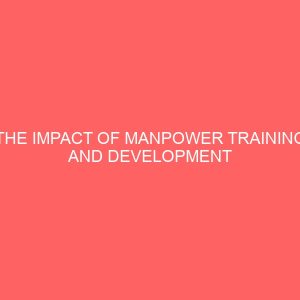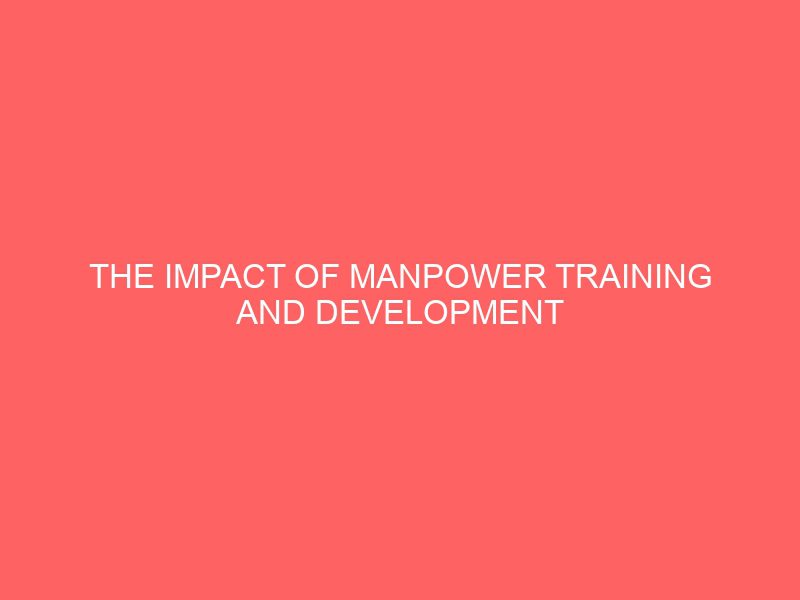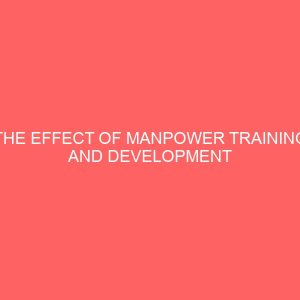Description
CHAPTER ONE
INTRODUCTION
1.1 BACKGROUND OF THE STUDY
Human Resources have played a significant role in the economic development in most developed countries such as United States of America, Britain and Japan among others. It can, therefore be concluded that a developing country like Nigeria, with its rich natural resources and the necessary financial support can also experience such economic success if the appropriate attention is given to the development and training of her human resource. It is thus seen that in Nigeria the government is taking adequate steps to ensure that people acquire the necessary knowledge and skills. The provision of secondary and technical schools, vocational training institutes and colleges, professional and tertiary institutions, as well as the educational reforms currently taking place in the country, are all geared towards the acquisition of skills and knowledge to ensure effectiveness and efficiency in our workplaces.
For instance, a manager in an organization will not be successful until he has subordinates beneath him who are well equipped with skills, talent and knowledge. To manage an organization both large and small requires staffing them with competent personnel. The formal educational system does not adequately teach specific job skills for a position in a particular organization. Few employees have the requisite skills, Knowledge, Abilities and Competencies (SKAC) needed to work. As a result, many require extensive training to acquire the necessary skills, knowledge, abilities and competencies (SKAC) to be able to make substantive contribution to wards the organization’s growth, (Barron and Hagerty 2001). If employees are to experience flexibility and effectiveness on the job, they need to acquire and develop knowledge and skills, and if they are to believe that they are valued by the organization they work for, then they need to see visible signs of management’s commitment to the their training and career needs. Training and development are the processes of investing in people so that they are equipped to perform. These processes are part of an overall human resource management approach that hopefully will result in people being motivated to perform. (Barron and Hagerty 2001). It goes without saying therefore that the training and development of employees is an issue that has to be faced by every organization. However, the amount, quality and quantity of training carried out vary enormously from organization to organization.
According to Cole (2002:329), factors influencing the quantity and quality of training and development activities include; the degree of change in the external environment, the degree of internal change, the availability of suitable skills within the existing work-force and the extent to which management see training as a motivating factor in work.
1.2 HISTORICAL BACKGROUND OF GUINNESS NIGERIA PLC
The firm Guinness Nigeria Plc came into existence in year 1950 with the sole aim of importing and distributing Guinness stout from Dublin for eventual sales in Nigeria. Due to the success of the product in the country it gave rise to a decision to establish a small brewery in the year 1962. The foundation stone of Guinness was laid at Ikeja on the 31st January 1962, by Arthur Benjamin Francis Guinness now the Earl of Irish to which titles he succeeded on his grandfather’s death until 1967 in active services during the 2nd world war.
Guinness Nigeria is a subsidiary of the prestigious Diageo Plc of the United Kingdom. The brewery was the first outside of Ireland and Great Britain. Other breweries have been opened over time – Benin City brewery in 1974 and Ogba brewery in 1982.
Guinness Nigeria produces the following brands – Foreign Extra Stout (1962), Guinness Extra Smooth (2005) Malta Guinness (1990), Harp Lager Beer (1974), Gordon’s Spark (2001), Smirnoff Ice (2006), Satzenbrau (1995).
Guinness Nigeria Plc is a company that believes in enriching its communities. This it has achieved by embarking on laudable Corporate Social Responsibility projects in several communities in Nigeria. These projects are Water of Life initiative, which currently provides potable water to over 500,000 Nigerians spread across several rural communities, from Northern to Southern Nigeria; scholarship and Guinness Eye Hospitals in three cities in Nigeria.
Nigerian Guinness is said to be twice as strong as Irish Guinness. In the 1800s, the Irish brewed the Guinness twice as strong, due to a fear of evaporation on the long voyage to Nigeria. However, the alcohol did not evaporate, and to this day Nigerians brew their Guinness twice as strong.
Guinness Nigeria limited became a public company In 1965 and was one of the first companies to be quoted in Nigeria stock exchange with shares being offered to Nigerian shareholders, 1200 Nigerian held 20% of the equity.
In 1971, a decision was taken to build a new Brewery at Benin at a cost 12 million to brewery larger beer, this was the biggest brewery ever built in Nigeria.
The company believes that investment in the training and development of its staff are wise investments. This has resulted in the establishment of training centers in Benin and Lagos (Ikeja).
Following the ban on importation of methods barely the company has conducted research into the use of maize and sorghum in place of malt in production of the different brands of beverages.
In the Nigerian market, Harp lager beer gained a remarkable success alongside Guinness stout, due to its good quality too hence received a wide patronage and now known as Guinness Nigeria PLC.
It was merely up to a decade of the brewery and marketing of harp that its brand loyalists started shifting their interest to the other hand. The complaint raised by Harp patronizes for gradually changing preference was as a result of the carelessness on the part of the brewers to eradicate particles discovered in the final product and these were major set-backs suffered by Guinness Harp.
In the year 1995 a new product line “satzenbrau” was in the market and it received attention in Lagos and west Ibadan to be precise for now.
In 1990 another product line “Malta Guinness”, was also in the market and it has received attention all over the country and outside the country.
It indeed received acceptance and as such requires effective management system, to guide against the future of all lines of product carried out by Guinness Nigeria Plc. (www.Guinnessnigeria.com).
1.3 STATEMENT OF THE PROBLEM
It is a well known fact that training enhances SKAC and ultimately worker performance and productivity in organizations.
Many organizations in Nigeria and indeed the public sector engage in training and development of staff and have departments, units and sectors in charge of training and development. Guinness Nigeria Plc is one such organization that has been practicing training and development since its beginning and particularly for the past ten (10) years. However, for some years now it appears training in Guinness Nigeria Plc is disorganized, unplanned and unsystematic, and several of its employees such as machine operators, junior and middle level engineers, accounts clerks, computer operators, secretaries, drivers and many other category of workers, have not qualified for any form of training nor is there any systematic process of staff development in place.
1.4 STATEMENT OF HYPOTHESIS
Null Hypothesis: adequate training does not create high performance in an organization.
Alternative Hypothesis: adequate training creates high performance in an organization.
1.5 RESEARCH QUESTION
the following are the statement of research question for this project research:
1. Will training and development of manpower in the organization lead to the attainment of the overall desired goals and objectives?
2. Is manpower training and development at Guinness Nigeria Plc planned and systematic?
3. Will motivation of workers lead to greater performance that will lead to the increased in productivity of the organization?
4. Has training offered you the opportunity to identify any potential you have for further development?
5. Does training and development improve skills and knowledge of manpower in organizations?
1.6 OBJECTIVES OF THE STUDY
The objectives of this study are to:-
1. Identify the major purposes of training and development, as well as the Key internal and external influences on training.
2. Ascertain the training and development policy in operation at Guinness Nigeria Plc.
3. Outline and explain the training and development practices and processes including the assessment of training needs, an outline of training methods, and the processes of monitoring and evaluating the plan.
4. Find out whether training and development schemes have positive effect on the performance of workers and productivity.
1.7 SIGNIFICANCE OF THE STUDY
It is expected that the study will inform the Management of Guinness Nigeria Plc and other organizations that to increase productivity, there is the need to have and retain well trained and motivated employees. It is also to help develop and maintain a quality work life, which will provide an opportunity for employees’ job satisfaction and self-actualization. Finally, it is to aid management of Guinness Nigeria Plc to introduce modern schemes for training and development, to be able to meet the challenges of change in the future.
1.7 SCOPE OF THE STUDY
The study is limited as it looks at the role and impacts that training and development policies and activities have played in the last ten years of Guinness Nigeria Plc life.
The scope of this study will generally be limited to two key human resource components i.e Manpower training and development in organizations in Nigeria.
1.8 LIMITATION OF THE STUDY
Problems such as the assurance of secrecy and indifference on The part of interviewees and respondents were limitations to the study as some of the employees felt uncomfortable and other were simply not bothered. The absence or inaccessibility of reliable records and reports on Guinness Nigeria Plc activities within the past ten years also limited the research investigation. The unwillingness of Management to reveal strategic information in the name of confidentiality is a limitation to the study.







